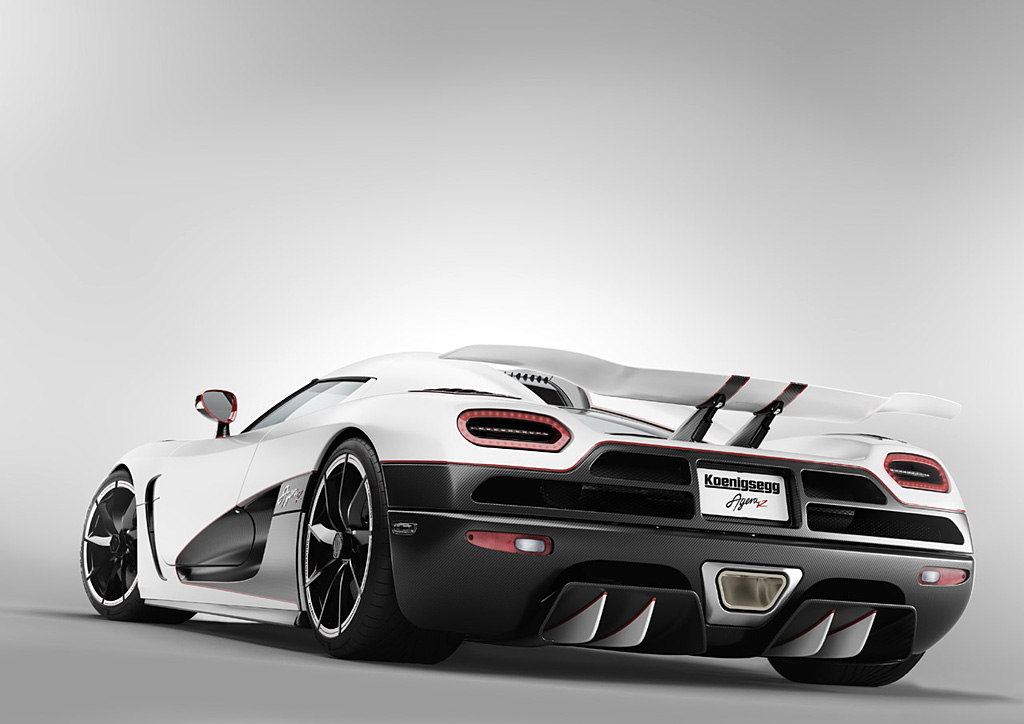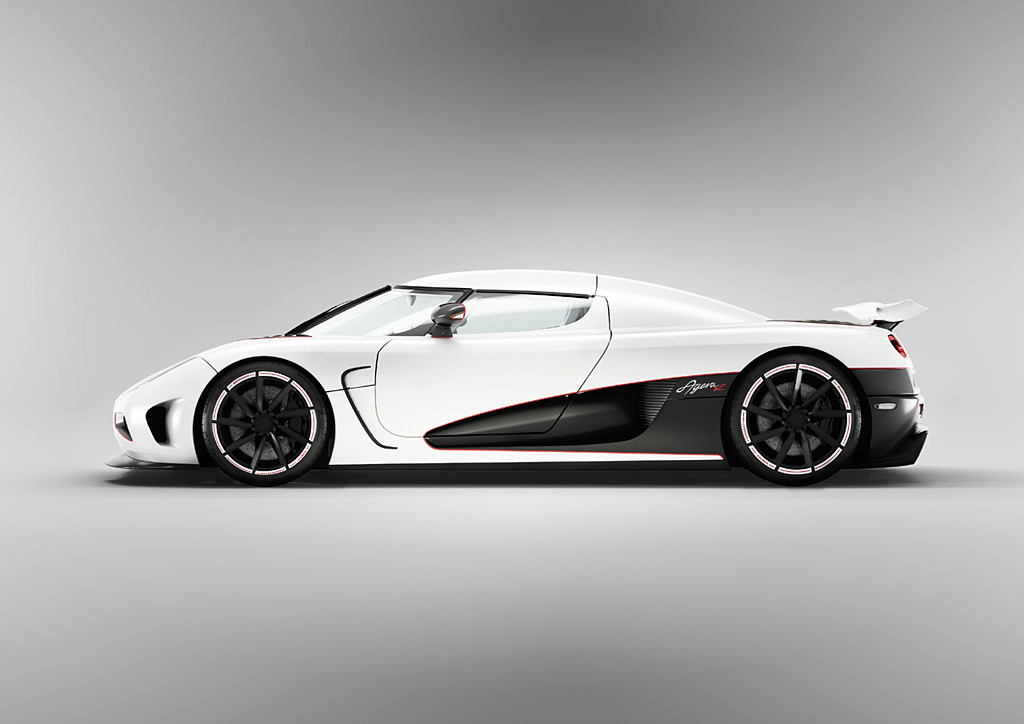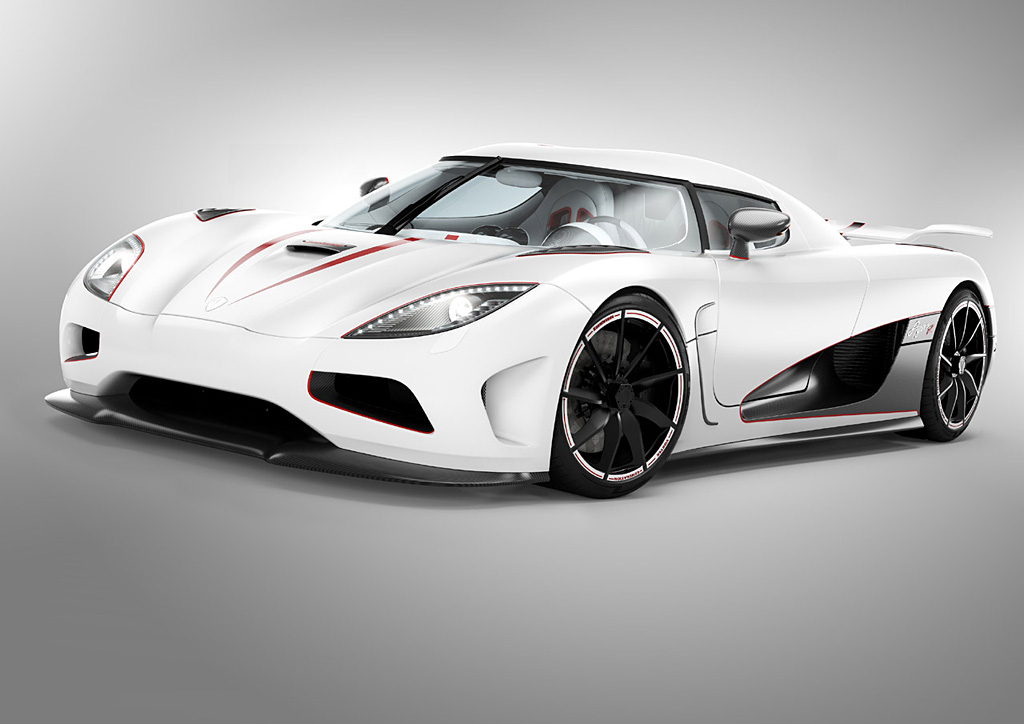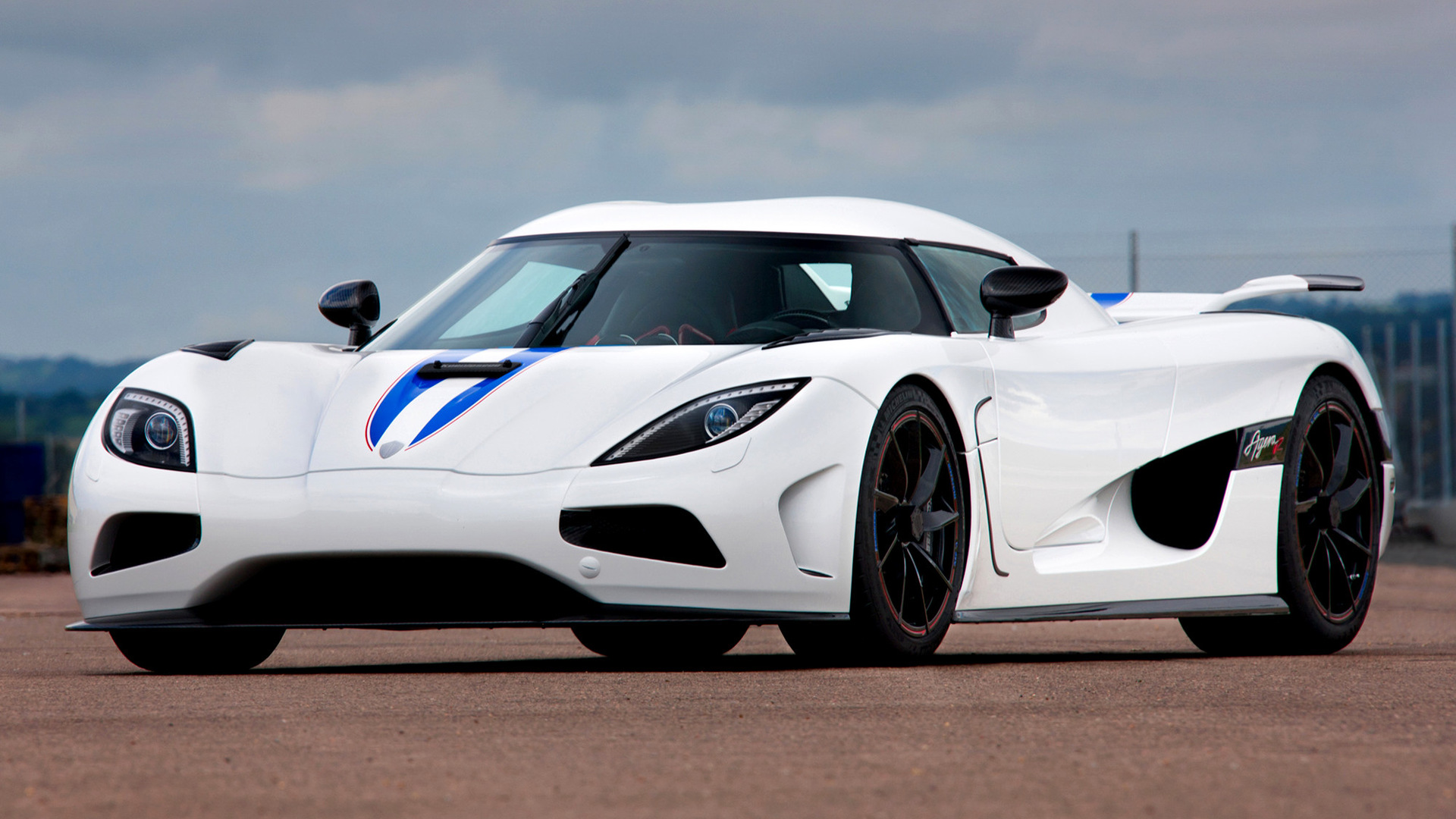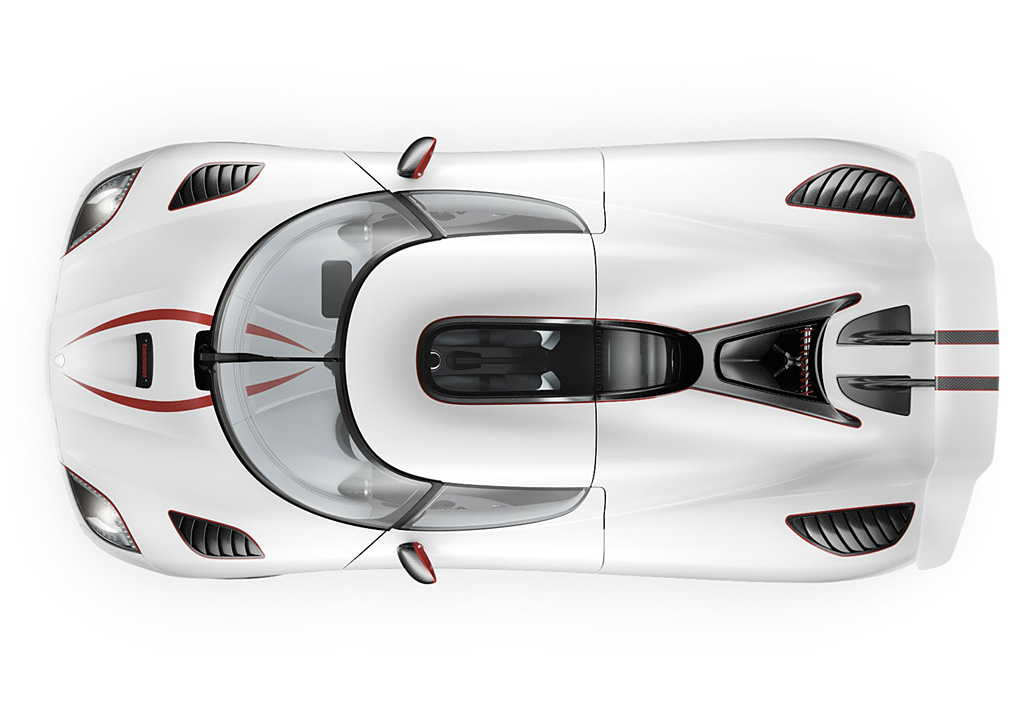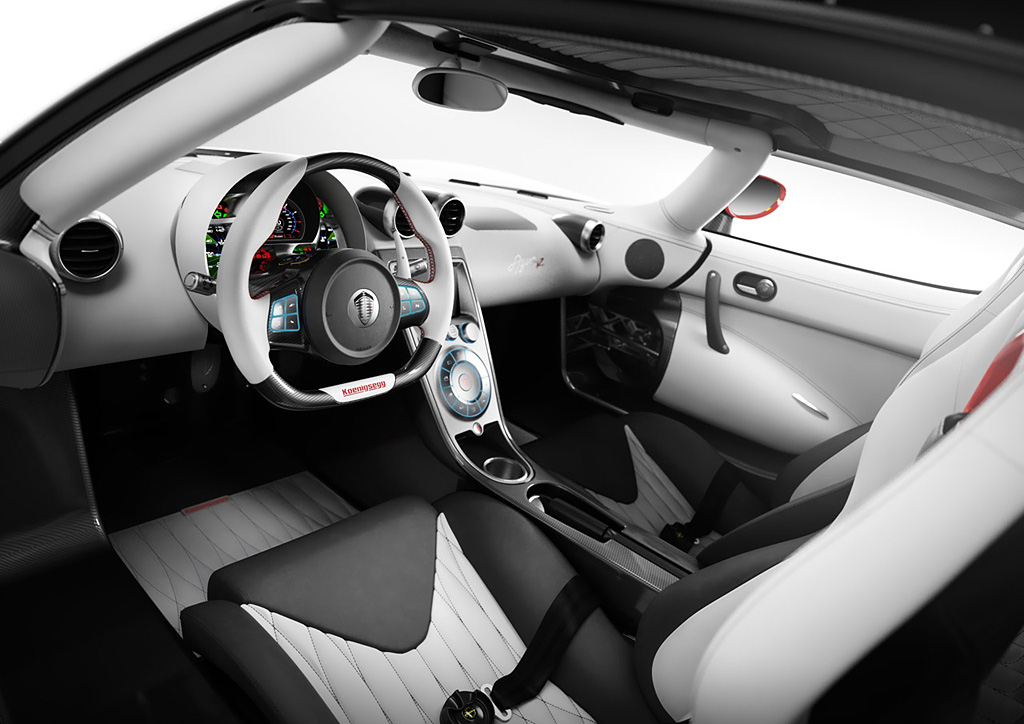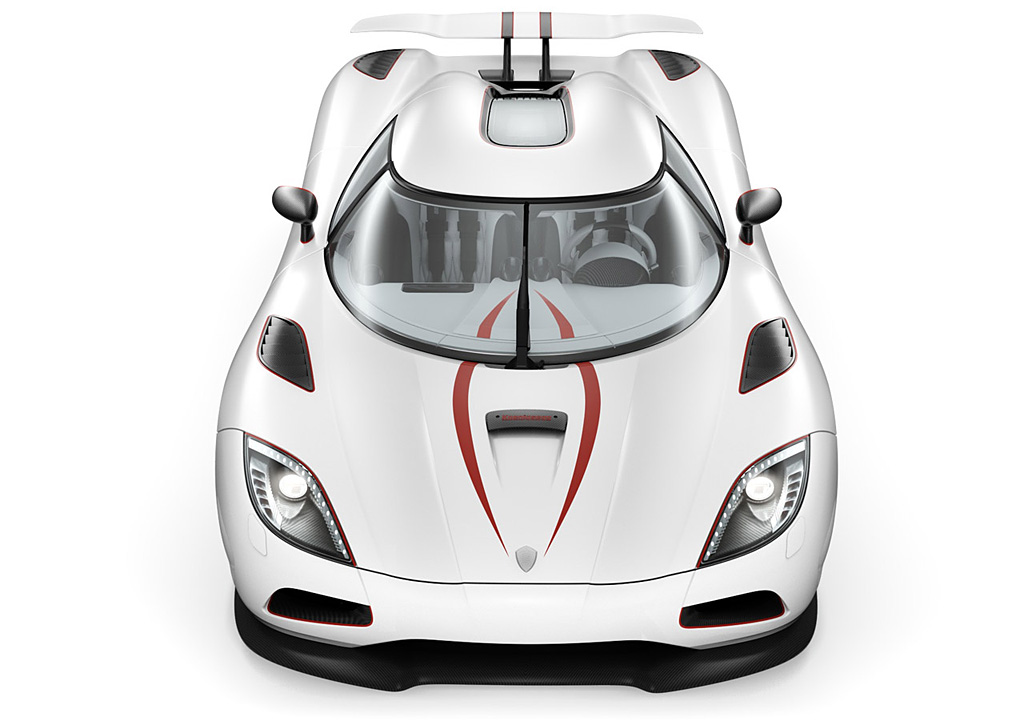2011 Koenigsegg Agera R
At the 2011 Geneva Motor Show, Koenigsegg released a new version of their Agera featuring the 5.0-liter Biofuel engine first seen in the CCXR. Along with several upgrades, the new model has a Borg Warner-developed twin turbo system and an optional active rear wing.
Press Release
This year at the Geneva Motor show Koenigsegg is presenting the brand new Agera R – Quicker than lightning! The Agera R on the Koenigsegg show stand – production car # 83 – is inspired by the legendary Speed Racer theme, as specified by the owner of the car. Speed Racers main colour is white – so is snow. Equipped with special Michelin tires and a custom made Thule Roof Box – Speed Racer is ready to attack the ski resorts!
Last year Koenigsegg presented a pre-production version of the upcoming Koenigsegg Agera. Since then the pre-production car and several test mules have continued the Agera development program. The Agera pre-production car has been driven by several influential motoring journals, resulting in raving reviews and awards, such as for example becoming the “Top Gear Hypercar of the Year”.
All in all the production versions of the Agera are created to take the Koenigsegg experience to the next level both on the road and the track, still maintaining the largest luggage space in the industry in combination with the unique Koenigsegg door system and detachable/stow-able hardtop.
There are several diferences between the pre-production car previously shown and the production versions. For example, the engine and gearbox confgurations are diferent and some revolutionary interior, chassis and aerodynamic features adorn the production version of the Agera that has never been shown before. For more information, please read the full press release below.
Design
The Agera is designed with the minimalistic “less is more” philosophy in mind. This philosophy means that the shape of the car has to be purely functional with no added features except those purely needed to meet regulation, added safety, ergonomics, practicality and aerodynamics. We believe that if this philosophy is followed, the car will also be beautiful as it is purely purposeful. A good analogy is the evolution of a dolphin that has had to meet similar criteria in order to reach their present confguration through the evolution of nature.
The Agera is proportionate, compact and muscular. Its timeless, efcient and distinctive shape is truly a testament to time. The original shape and concept of the Koenigsegg CC, created 15 years ago, is still valid, fresh and highly competitive today. The Agera manage to stay true to the original philosophy, shape and size of the original CC. At the same time, it looks, feels
and performs like something belonging to the future.
Engine
Koenigsegg difers from other low volume hypercar manufacturers by the fact that Koenigsegg develops and produces its own engine in-house. This is, by most observers and competitors, deemed as more or less impossible or way too expensive to even consider.
However, year after year Koenigsegg has proved them wrong. Not only are the engines developed in-house, they also have class leading characteristics in many important areas. To mention a few: Lightest and most compact hypercar engine in the world, weighing only 197 kg complete with fywheel, clutch, dry sump system, Inconel exhaust manifold with turbo. The low engine weight is quite astonishing, as the Agera engine also has class leading power and torque characteristics. To give an example, the Koenigsegg 5 litre V8 bi-turbo engine develops more than 900 hp on 95 octane regular fuel, and more than 1100 hp on E85 bio fuel. The Agera produces over 1000 Nm of torque from 2500 rpm and in the Agera R format the engine has a peak torque of 1200 Nm over a 3300 rpm rev range, showing great fexibility.
These are extraordinary numbers considering the size and reliability of the engine without forsaking drivability or fexibility. This is truly downsizing, without drawbacks. These characteristics make it one of the most fexible and easy to use hypercar engines in the world.
To give a hint of how diferent the Agera engines are compared to other production car engines, it is easy to look at the BMEP value (Brake Mean Efective Pressure) in the cylinders during maximum power output. The best production diesel and petrol engines from other leading manufacturers have a maximum BMEP of around 22 bar.
No other production engine in the world, regardless of car type, has the same amount of power potential compared to its EU cycle average CO2 emission(310g of CO2) or cycle fuel consumption( 14,7 litre per 100 km / 16MPG). However, what makes Koenigsegg most proud is how drivable, smooth, responsive, torquey and reliable the engines are – especially given their extreme performance.
Transmission
The newly developed 7 speed gearbox for the Agera features a world’s frst dual clutch system for a single input shaft gearbox. In order to keep the gearbox light, compact strong and reliable, Koenigsegg together with Cima chose to develop a new gearbox type that enables the use of a combination of a dry and wet clutch system, in order to get class leading shift times. First there is the normal twin disc dry clutch that operates in a traditional fashion. Then there is a hydraulically operated wet clutch-brake
inside the gearbox that is engaged during each up shift in order to slow down the input shaft, simultaneously as the gears are changed and prior to the normal synchronisation. This cuts the synchronisation time by two thirds, as the gear is pre-synchronized. The result is a very sporty, smooth and extremely fast shift. Compared to a traditional DCT system, this gearbox is lighter, smaller, has less moving parts and gives a more distinct shift feel, with almost no interruption to the acceleration.
Furthermore, the electro hydraulic shift mechanism actuates the shift forks directly with no intermediate mechanical parts. This brings down the inertia of the shift mechanism and any potential slack is minimized since the shortest possible path of engagement is achieved.
The entire transmission weighs only 81 kg, which is by far the lightest 7 speed Hypercar transmission in the world. The transmission can also be set in full auto mode.
The small size and very low weight, considering the longitudinal 7 speed layout, made it possible to maintain the shortest in class rear overhang, and thereby excellent central mass position and neutral behaviour in extreme conditions.
Koenigsegg E-Diff
The Koenigsegg Electronic Diferential (E-Dif) is lighter and faster, compared to traditional E-Dif solutions. The diference lies in the fact that Koenigsegg has retained a limited slip diferential with plates and ramps with a built-in amount of analogue limited slip functionality. This means that the active hydraulic element can be smaller, more compact and therefore faster and lighter compared to traditional E-Dif solutions. The analogue part of the functionality also has zero processing time as it reacts directly. The analogue system is supplemented by a digital active system.
This way Koenigsegg has obtained one of the lightest and fastest E-Dif solution on the market. Furthermore the Koenigsegg developed algorithms that control the E-Dif, takes input from; throttle angle, g-force, steering wheel angle, yaw angle, car speed, engine rpm, selected gear, plus weather condition.
The way all this data is analysed and how the car reacts to this data also makes the Koenigsegg E-Dif unique and that makes the Agera very safe on the limit and improves performance and feel.
The Koenigsegg E-dif works in harmony with the new traction control system that is the fastest reacting in the industry, with auto adapt functionality to diferent road conditions and driving styles as well as several manual settings.
Chassis
The Agera´s unique carbon fbre monocoque chassis is designed to achieve its maximum stifness without a roof, as the roof is detachable and stow-able in the front of the car. This in itself is an unusual feature for such a compact Hypercar. The Koenigsegg carbon monocoque chassis has an astonishing stiffness of 65.000 Nm/deg and only weighs 70 kg including the integrated fuel tanks. The result of constant weight saving exercises is a dry weight of only 1330 kg making the Agera the lightest fully homologated Hypercar presently in production.
Suspension
The suspension geometry of the Agera was designed to further enhance the award winning behaviour of the CCX. The Agera track is wider at the front compared to the rear of the car, compensating for the narrower front tires and giving the car a square stance of 2 meters in both the front and the rear.
In typical Koenigsegg tradition, the Agera has the longest wishbones of all hypercars presently in production. Long wishbones have several advantages – for example: less track width deviation during wheel movement or cornering and improved geometry over a longer wheel stroke. This is one of the reason why F1 cars have very long wishbones. The wishbones are produced from
seamless aeronautical chrome-molybdenum tubing, in order to minimise weight in combination with maximum strength and stifness.
The extremely strong and light uprights are machined from 7075-T6 aeronautical grade aluminium, and contains 240 mm SKF dual angle contact bearings, normally only found on Lemans prototype cars. The very large bearings contribute to the overall stifness of the wheel assembly and therefore give better control, handling and comfort. The uprights have large 4.5” diameter carbon fbre cooling ducts for the brake discs in order to maximise brake cooling.
Brakes
The Agera is equipped with the absolutely latest ABS technology and is based upon, a very lightweight and performance oriented, racing ABS system. The system makes it possible for the ABS function to react to diferently depending on
performance mode. Furthermore the ABS braking system operates on massive 392×36 mm and 380×34 mm ventilated and drilled ceramic discs, for unparalleled braking performance and zero fade regardless of track or road condition.
Aerodynamics
The Aerodynamics of the Agera has been honed and perfected over many years in CFD and wind tunnel in order ensure best possible outcome. Even with the massive dynamic rear wing, the drag of the Agera is only Cd 0.33, in high speed mode and Cd 0.37 in track mode. Even though the Agera is a full 2 meters wide, it only has a frontal area of 1.87 m2. This results in a Cd*A value of only 0.62 and thus a theoretical top speed of around 440 km/h (Agera R), given the gear ratio and power available.
All Agera models are limited to 375 km/h in standard mode, but can be unlocked by Koenigsegg for shorter periods of time, if all necessary conditions are met, such as road condition, tire wear, service level of car etc. The car is set in full speed mode by unlocking the top speed mode in the Infotainment system.
The two large side air intakes greatly add to the Agera´s high speed stability as they ensure that the pressure point of the car is behind the mass centre of the car. This makes the car more directionally stable with increasing speed. This is a crucial safety feature when it comes to driving at extreme speeds. Great care has been taken that the car also is stable under high speed braking. The front splitter and rear difuser has been designed and optimized with this in mind.
For maximum performance and safety it is important that the down force stays as constant as possible even in yaw situations. Therefore the rear difuser was developed and evaluated specifcally to give substantial down force even at wide yaw angles.
Hypercars of today generate massive amounts of down force in low to medium speed and less down force in very high speed, in order not to overload the tires and not to create too much drag. Most hypercars therefore have heavy hydraulically operated wings and faps to cater for this need.
Interior
The interior of the Agera is like no other car. No other materials than those deemed worthy by Koenigsegg are allowed in the interior. This means that what you get to touch and see inside the Agera is only aluminium, carbon fbre, precious metals, alcantara and aniline leather. All switch gear is highly bespoke and features wonderfully unique solutions, as for example the
Koenigsegg Ghost light, that make solid aluminium buttons gleam with LED powered symbols appearing out of nowhere.
A world frst in the car industry. The illumination shines through the billet aluminium buttons and surfaces by way of almost invisible micro holes, creating excellent visibility of the symbols as well as a very clean and stylish appearance, framed by an all-new carbon fbre centre console and tunnel assembly.
The new super light full carbon airbag steering wheel incorporates many vital functions directly in front of the driver. Similarly to the CCX, the shifting paddles are mounted directly on the steering wheel to enable shifting without taking your hands of the steering wheel during hard cornering.
The central high-defnition touch screen infotainment system controls the audio functions, satellite navigation, Bluetooth phone and secondary functions such as performance meters and car telemetrical data.The very comfortable and optionally heated carbon seats are great for long journeys but also give excellent lateral support when needed.
The Interior of the Agera is truly minimalistic and efficient in the purest Swedish sense. Nothing in the interior is there only to add visual drama; instead everything is there for a functional purpose. According to Koenigsegg, this is the essence of beauty, as it follows a less is more philosophy that embodies every engineering aspect of the Agera.
The Configurable Instruments is specifically developed for the Agera by Koenigsegg. It features a unique and configurable interface that can be adapted to driver specific demands. As it is connected to the cars CAN bus system it freely communicates with the infotainment screen and all other functions in the car.
By pushing the left stalk button, different priority graphics can be chosen, depending on need. For example in track driving mode, there is a focus on; RPM, pressures, temperatures, lap times, and g-forces. Compared to GT mode, where: car speed, auto shift, satnav, power, music etc is prioritized.
Specs & Performance
| type | Series Production Car |
| released at | 2011 Geneva Motor Show |
| built at | Ängelholm, Sweden |
| price $ | $ 1,400,000 |
| price €/td> | €990,000 |
| price £/td> | £845,000 |
| engine | Koenigsegg Biofuel V8 w/Dry Sump Lubrication |
| position | Mid Longitudinal |
| aspiration | Twin Turbo |
| block material | Aluminum |
| valvetrain | DOHC, 4 Valves per Cylinder |
| fuel feed | Multi-Point Fuel Injection |
| displacement | 5000 cc / 305.1 in³ |
| compression | 9.2:1 |
| power | 831.5 kw / 1115 bhp @ 7200 rpm |
| specific output | 223.0 bhp per litre |
| bhp/weight | 786.32 bhp per tonne |
| torque | 1200 nm / 885.1 ft lbs @ 5600 rpm |
| body / frame | Carbon Fibre/Kevlar Body over Carbon Fiber & Aluminum Honeycomb Semi-Monocoque w/Steel Front Cro-Moly Steel Subframe |
| driven wheels | RWD w/E-Diff |
| wheel type | Carbon/Magnesium w/Center Lock |
| front tires | 255/35–19 |
| rear tires | 335/30–20 |
| front brakes | Carbon Ceramic Discs w/6-Piston Calipers |
| f brake size | 36 x 392 mm / 1.4 x 15.4 in |
| rear brakes | Carbon Ceramic Discs w/6-Piston Calipers |
| r brake size | 34 x 380 mm / 1.3 x 15.0 in |
| front wheels | F 48.3 x 24.1 cm / 19 x 9.5 in |
| rear wheels | R 50.8 x 31.8 cm / 20 x 12.5 in |
| steering | Rack & Pinion w/Power Assist |
| f suspension | Double Wishbones w/Inboard 2-Way Adjustable VPS Dampers, |
| r suspension | Double Wishbones w/Inboard 2-Way Adjustable VPS Dampers, |
| curb weight | 1418 kg / 3127 lbs |
| wheelbase | 2662 mm / 104.8 in |
| front track | 1700 mm / 66.9 in |
| rear track | 1650 mm / 65.0 in |
| length | 4296 mm / 169.1 in |
| width | 1998 mm / 78.7 in |
| height | 1120 mm / 44.1 in |
| transmission | 7-Speed AMT |
| tran clutch | Dual-Clutch |
| gear ratios | 3.364:1, 2.875:1, 1.773:1, 1.267:1, 1.000:1, 0.833:1, 0.711:1 |
| drag | 0.30 Cd |
| emission | 310 g/km |
| fuel capacity | 80 litres or 18.48 gal. |
Pictures & Galleries
See More Koenigsegg Agera R Images
Videos
See More Koenigsegg Agera R Videos


